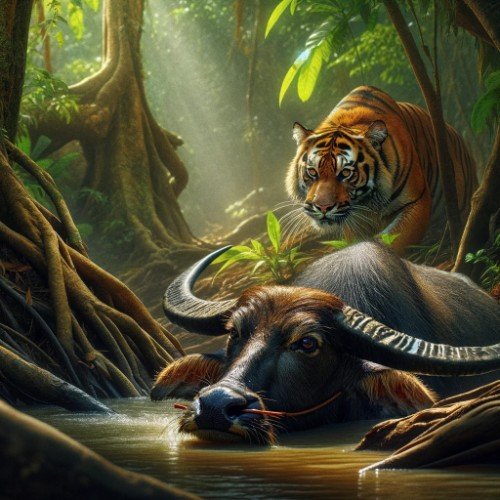When we think of the animal kingdom’s heavyweights, the water buffalo and the yak often don’t receive the limelight they deserve. These two species, hailing from dramatically different environments, offer fascinating insights into the adaptability and strength found in nature.
A Tale of Two Habitats
The water buffalo is synonymous with the lush wetlands and floodplains of the Indian Subcontinent and Southeast Asia. Their lives are inextricably linked to water sources, which they rely on for their daily activities. In contrast, the yak thrives in the harsh, frigid climate of the Tibetan Plateau and surrounding mountainous regions. Adapted to high altitudes and cold temperatures, yaks are a testament to nature’s ability to thrive under extreme conditions.
The Ecosystem Engineers
Both animals play pivotal roles in their respective ecosystems. Water buffaloes, with their grazing habits, help maintain the delicate balance of the wetlands. Their movements create water wallows and paths, crucial for other wildlife, and their dung enriches the aquatic ecosystem.

Yaks, on the other hand, are vital players in the high-altitude ecological tapestry. Their grazing patterns maintain plant diversity, and their movements aid in seed dispersal, helping to sustain the fragile flora of their mountainous homes.
Buffalo and Yak Predators
The wild water buffalo and the yak, though formidable in size and strength, are not invulnerable in their respective ecosystems. Their interactions with natural predators paint a vivid picture of the predator-prey dynamics in nature.
Water Buffalo Predators
In the lush landscapes where water buffaloes roam, they occasionally find themselves targeted by some of the most formidable predators in the animal kingdom, notably tigers and packs of wild dogs.
- Hunted by Tigers: The tiger, an apex predator, is one of the few animals that can take down a fully-grown water buffalo. These confrontations, though rare, are intense. Tigers rely on their stealth and power, often ambushing the buffalo, aiming for the neck or throat. A successful hunt requires immense strength and strategy, as the buffalo’s size and horns make it a dangerous adversary.
- Threat from Wild Dogs: Packs of wild dogs, while not as powerful individually as tigers, can be equally threatening due to their numbers and coordinated attack strategies. They tend to target younger or weaker members of the buffalo herd. These dogs use their endurance and teamwork, harrying the buffalo until it becomes exhausted, making it easier to bring down.
- Buffalo’s Defense Tactics: In response to these threats, water buffaloes have developed robust defense strategies. They are highly social animals, and their strength lies in their numbers. When threatened, the herd will form a protective circle around the young, sick, or old, with the strongest members facing outward, ready to use their massive horns and sheer bulk to fend off attackers.

Yaks: The High-Altitude Prey
In the colder, more rugged terrains of the Tibetan Plateau, yaks face different but equally challenging predators: primarily snow leopards and wolves.
- Snow Leopard Hunts: The snow leopard, a master of stealth in its snowy habitat, preys on young, old, or sick yaks. These big cats use their incredible agility and surprise to their advantage, often attacking from above or from a hidden position. Their strategy is to deliver a fatal bite, usually to the neck or throat.
- Wolf Packs: Wolves, much like wild dogs, hunt in packs and use their endurance and numbers to take down their prey. They often target more vulnerable yaks, especially those separated from the herd. Wolves rely on wearing down their prey in long chases, exploiting the harsh terrain and weather conditions to their advantage.
- Yak’s Defense Mechanisms: Yaks, when threatened, exhibit defensive behaviors similar to water buffaloes. They form tight groups, with the more vulnerable members in the center. Their thick fur offers some protection against bites, and their sturdy horns are used effectively in defense. Yaks also have an advantage in their natural terrain, as their sure-footedness in rocky, uneven landscapes can help them evade predators.

The Human Factor
Despite these natural threats, human-induced challenges like habitat loss, hunting, and overgrazing pose greater risks to both species. For water buffaloes, the loss of wetlands and floodplains due to agricultural expansion and urbanization reduces their habitat and food sources. Similarly, yaks suffer from overgrazing and habitat degradation, often exacerbated by the crossbreeding with domestic cattle, leading to a loss of genetic purity and resilience in wild populations.
In conclusion, while water buffaloes and yaks are equipped with impressive natural defenses against their predators, the relentless march of human-induced changes remains a significant threat to their survival. Understanding and mitigating these impacts is crucial for the conservation of these magnificent creatures and the ecosystems they inhabit.
Clash of the Titans: Strength, Weapons, and Fighting
The water buffalo is renowned for its immense strength and formidable horns, spanning over two meters in some cases. When threatened, they become aggressive, using their horns and bulk in powerful charges. Their fighting style is a display of brute force and intimidation.
In contrast, the yak, though slightly smaller, is no less impressive. Its dense fur and sturdy horns serve as natural armor against both the elements and foes. Yaks tend to be more defensive, using their horns and body mass to fend off attackers rather than initiating conflict.
Survival of the Fittest: Endurance and Adaptability
The water buffalo’s endurance is showcased in its ability to traverse swamps and muddy terrains, coupled with a high tolerance to heat. The yak, equipped with an extraordinary lung capacity and blood adapted for low oxygen levels, demonstrates remarkable endurance in the face of sub-zero temperatures and high-altitude challenges.
Who would Win?
Considering all the factors, including their respective strengths, fighting styles, and adaptability, the water buffalo might have a slight upper hand in a direct confrontation, primarily due to its larger size, powerful offensive tactics, and aggressive nature. Thus, it could be estimated that the water buffalo has about a 60% chance of emerging as the victor in such a scenario.
However, the yak, with its resilience, defensive capabilities, and endurance, especially in harsh conditions, should not be underestimated. Therefore, it could be assigned a 40% chance of winning.




